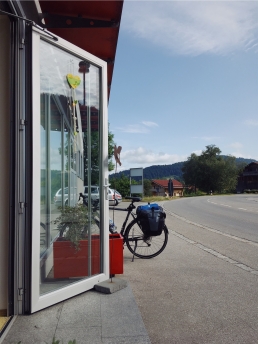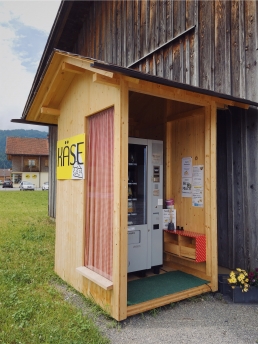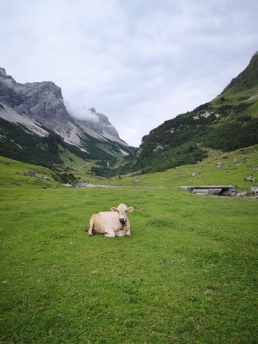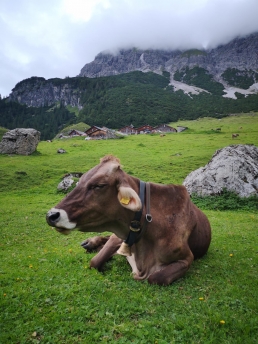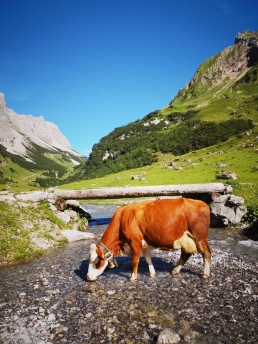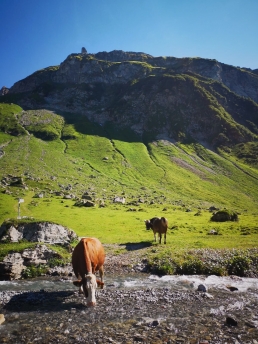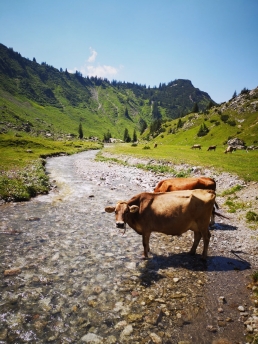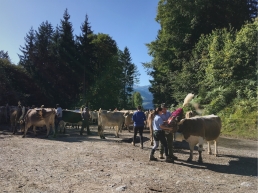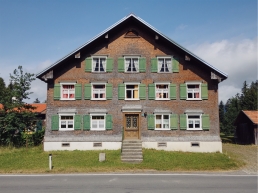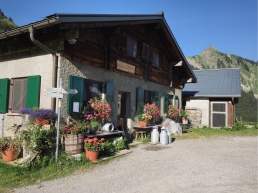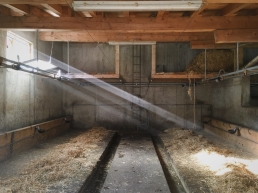With a total ascent of 1,609 metres in altitude, this would not be an easy first stage, that was clear. Like the slow crescendo of a concert movement, the relatively flat passage through the Bregenzerwald is followed first by a slow ascent to Damüls and then – quasi as a final, reversed cadenza – a short steep climb to Faschina in the Walser Valley. But one after the other. Early in the morning in Oberstaufen (Allgäu) I sat on a bench of the observation platform “Hochgratblick”, with the two angels of the large sculpture swinging their trumpets towards the mountains in my back, and drank my coffee. I could not imagine a more fitting beginning for the great concert of the Alpine crossing. Perhaps the imaginary fanfare would even provide some tailwind.
Triumphantly I started the tour with the easy short descent from Oberstaufen down into the valley of the river Weißach. Afterwards a last flat stretch through the Allgäu followed. After about 7 km I reached the border to Austria. The small border bakery in the old customs house (still on the German side) was already open. I sat down at the only table in front of the building and after a short time an elderly motorcyclist joined me and I got into conversation with him. A Bavarian through and through, who still repaired his machines himself. We talked about the blatant difference between the Northern and Southern German landscapes, but also about the heavy storm the day before, of which nothing could be seen anymore.
Map & Track
km 01 — 63

TERRAIN
Mountains

DISTANCE
62.35 km

DURATION
1 day (ca. 7 hrs)

ALTITUDE DIFF.
963 m

CLIMB
1,609 hm

DESCENT
912 hm

HIGHEST
1,491 m

LOWEST
528 m
FITNESS
●●●●○
LANDSCAPE
●●●●○
NATURE
●●●●○
CULTURE
●●●○○
At the border to Austria
km 7 of the stage | km 7 of the tour
The actual border between the Allgäu and Vorarlberg lies behind a bend with a short steep climb. A gentle hilly landscape in a wide valley follows and I roared in the morning sun on the little frequented and perfectly asphalted federal highway 205 past Riefensberg, Krumbach and Hittisau to Lingenau.
On the 90 meter high Lingenau bridge, I got a real mountain feeling for the first time when I could watch a large group of whitewater canoeists deep down in the valley of the Weißach river – as good as I could through the bridge, which was completely blocked off with wire mesh. Here I made my first acquaintance with the Bregenzer Ach, which would now accompany me on a stretch of almost 30 kilometres through the Bregenzerwald.
Today, the Bregenzerwald is known above all for its “Cheese Route” – an association of production and restaurant businesses that have dedicated themselves to the traditional production and concerted marketing of this most important export product of their region. The tourism initiative has succeeded in making Bregenzerwald mountain cheese known far beyond the borders of the state. Direct sales take place in a very modern way via the somewhat strange “cheese vending machines”, which, however, do not only sell cheese, but also local meat products, milk and sometimes jams and sweets. Some farms even offer the possibility to have the cheese delivered by parcel service.
But how did it actually come about, historically speaking, that the entire Alpine region was so strongly fixated on dairy products, especially products made from the milk of Alpine cattle? Hardly any other regional economy in Europe is as much tailored to, dependent on and influenced by a single animal species as the Alpine region. The cows are omnipresent, as is the associated infrastructure of stables, drinking troughs, pastures, and of course the typical smell – a mixture of grass, hay and manure. The cows give identity, a sense of home. Each region traditionally had its “own” cow breed. In Central Switzerland, Graubünden and Vorarlberg, brown cows have been grazing mainly since the Middle Ages. In the Bernese Oberland, on the other hand, it was mainly the pale red Simmental Fleckvieh that was found. In the Valais, small brown-spotted high mountain cows grazed in the pastures. In Fribourg and north-western Switzerland, red and black cattle were kept. The Swiss Brünig-Napf-Reuss line is an example of this dissection. At this cultural boundary, not only isoglosses, folk customs and even skat leaves differ, but also the traditional ranges of Fleckvieh and Braunvieh. Even today farmers still talk about it when there are cows with “wrong” spotting in another herd. And even North German “Holstein cattle” with their high milk yield and low fat content are considered “foreign” everywhere in the Alps. They are denied the ability to move around and also the toughness. Even the dainty fawn-brown Jersey cows with low milk yield and high fat and protein content are viewed with scepticism. Actually, as the tradition-conscious alpine inhabitant secretly sees it, only the traditional cattle of his region belong on the pasture.
But in the historical context, the matter is quite different: all the cows, whether they are grey-brown or purple, spotted or not, are descended from a single original breed of the same animal species, the Eurasian domestic cattle (Bos taurus), and its origin is far from the Alps. It is the result of the domestication of the Eurasian aurochs (Bos primigenius) in the region of the fertile crescent in the Near East. In the territory of today’s Levant, in Syria, in southern Turkey and in the Mesopotamia of today’s Iraq, the first nomadic hunter-gatherer cultures began breeding animals from around 9500 BC onwards. Domestic cattle, domestic sheep and domestic goats were gradually liberated from the genetic corsets of their wild ancestors and carried along with the community as a living stock of meat and milk. In the “Neolithic Revolution” with the first sedentary farming cultures, the domestication of animals and the systematisation and intensification of livestock farming took place even more radically, not least because of the introduction of the yoke and the use of oxen to plough the fields. Waves of migration caused the spread of the new animal breeds. A few thousand years later, the first shepherds with their herds and the first settled farming communities with livestock had crossed the Bosphorus. Further north, ecumenism spread across the shores of the Black Sea to Western Europe. Still a little later, the first cows probably entered the steep and rocky Alpine soil.
Everywhere they went, the domestic cattle became the object of cultic worship. In Eurasian mythology, the bull stood on the one hand for procreative power and fertility, on the other for the power of the heavens, which are constantly being pulled by a stoic bull in the yoke connected to the axis of the world. In the Mesopotamian Gilgamesh epic, the king of Uruk killed the mighty “celestial bull”, which has since been commemorated by the constellation “Taurus”. The Greek father of the gods Zeus approached the Phoenician princess Europa in the form of a bull and abducted her to the island of Crete. Their son became King Minos of Crete. Poseidon punished him by making sure that his wife cheated with the celestial bull, from which the human-bull mixture Minotaurus emerged. King Minos had the monster imprisoned in the labyrinth of the brilliant master builder Daidalos and offered human sacrifices to appease him. Only Theseus finished the sacrificial rite and killed the monster. Also the hero Heracles must tame a bull in his eighth “Herculean task”. In Iranian mythology the earth is carried by a bull. Cows were worshipped in ancient Egypt as well as in India, where the proverbial taboo of “holy cows” comes from. Islamic conquerors drove their armies forward with cows, because their Hindu opponents then did not dare to attack. No less proverbial became the “golden calf” that the disobedient Israelites forged from their gold jewellery. More recent traces of cattle cults in Central Europe, especially in the Alpine region, are, for example, the decorated Pentecost ox and the traditional ceremonial driving down of cattle from the mountain pastures in autumn.
Meanwhile, the wild ancestor of this celebrated breed of farm animals – the aurochs, native to Europe for at least 275,000 years – continued to exist alongside the settled cultures of the ambitious homo sapiens. In the vast and dense forests of Europe, the primeval animal was able to hide and survive until more recent times. The Roman commander Julius Caesar found it in the Hercynian forest in the sixth decade BC in the area of today’s German low mountain ranges and described it in “De bello Gallico” as a typical regional large animal species (besides deer and elk). The oxen were “somewhat smaller than elephants” and so strong and wild that they could not be tamed. The Germanic tribes would hunt them using traps and use their long horns as drinking vessels and trophies. Of course Caesar had the wild beasts brought to Rome and presented them at his animal hunts which sometimes lasted up to five days. The Germanic tribes had also worshipped the aurochs and dedicated the second rune in their alphabet, Futhark, to him: the U-shaped rune “Uruz” symbolized his horns. In mythology, it thus represented the untamed strength of the aurochs, its boundless creative power, inner strength, vitality and endurance. Whoever killed such a showpiece of strength was considered one himself. Even in the early medieval Nibelungenlied it is said that the hero Siegfried hunted down four oxen (“starker Ure viere”).
In the early medieval reality aurochses must have been extremely rare. Five centuries after Caesar’s records, the Western Roman Empire had perished in the turmoil of the migration of peoples. But when the crises were over and new empires were born, the number of people in Europe increased again. Likewise, the number of their herds and their need for grazing land increased.
The aurochs would be a little smaller than elephants and so strong and wild that they cannot be tamed. The Germanic tribes would hunt them by means of traps and use their long horns as drinking vessels and trophies.
—Julius Caesar in “De bello Gallico”
The displacement of wild animals happened systematically. Since the aurochs were not allowed access to the gene pool of their own farm animals, thus endangering the success of domestication and breeding, they were heavily hunted and died mainly by the weapons of high nobility, because aurochs hunting was a royal privilege. The Merovingian and Carolingian clearing waves in the 7th to 10th centuries and another Franconian clearing wave in the 11th century destroyed and dispersed the last dense Central European primeval forests, destroyed the natural habitat of many wild animals and shifted their last retreats far to the north and east. The last European aurochs died in 1627 in a forest near Warsaw in Poland. When a skeleton was recovered from a bog near Weimar in 1821, Johann Wolfgang von Goethe recognised its importance and personally supervised its restoration. (The aurochs skeleton is now exhibited in the Phyletisches Museum in Jena).
Meanwhile, extensive Alpine farming had also begun in the Middle Ages. Shepherds and mountain farmers gradually cleared the wooded mountain areas from top to bottom in order to develop or enlarge higher-lying alpine pastures. Seasonal farming created the characteristic landscape form of mountain pasture. An early form of economic specialisation set in, and, as was once the case with the aurochs, domestic cattle now drove sheep and goats from the pastures. Since the opening of the Gotthard route over the main Alpine ridge in the 13th century, cattle exports, initially to the Alpine foothills, had become increasingly important. Soon milk and cheese products were added. Growing population pressure and the search for ever new agricultural land led to migration movements such as that of the Walser. With the emigrants and via the trade routes, knowledge and skills in pasture farming also spread and standardised and professionalised the business. By the 15th century at the latest, the cow had established itself as the main economic factor. Its products meat, milk and cheese were exported to other European countries on an ever-increasing scale. Soon the marketing as a “domestic quality product” began.
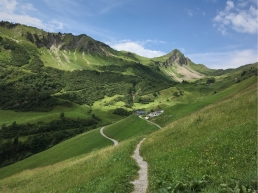
In the 19th and especially in the 20th century, mechanisation, mass production and global trade brought about extreme changes, the aggravation of which continues to this day and which even the tradition-conscious Alpine economy cannot escape. This could not be clearer than in the tourism project of the “Cheese Route Bregenzerwald”. Due to the rapid fall in prices of all kinds of cheese in the wake of competition from large retail chains, more and more alpine dairies in the Alpine region are having to rethink and develop new sales strategies. Exclusive ties to individual bulk buyers, who can dictate all conditions including the price, are proving to be risky and potentially ruinous. The unrestricted intra-European competition with the incomparably larger agricultural multinationals such as Nestlé and Danone, for whom cheese is a multi-billion-dollar business, is also making life difficult for farmers. About a third of the cheese consumed worldwide comes from the EU. In addition, the European Union regulates in the direction of sterility and thus, intentionally or unintentionally, prefers artificial cheese made from milk powder and discriminates against the spicy Alpine cheese made from fresh milk.
More and more dairies have therefore long since switched to the direct sale of specialities. In some cases they now only produce mountain cheese from raw milk, which for centuries was the main foodstuff of the local population. They know more about this than any large company. Without the agricultural aid from the EU and the country of Austria, however, it would not be possible. You have to be able to afford to set up cheese vending machines at a cost of several thousand euros. In order to keep the quality constantly high, there are strict requirements for cheese production prescribed by the state. Appropriate keeping of the species, cleanliness of the farms and facilities etc. are regularly checked. Above all, the use of silage-free milk is important – milk from cows that are fed without silage fodder and exclusively on grass and hay. Whether in reality one or two balls of concentrated feed wheat find their way into cow bellies is another matter.
So far, the history of the Bregenzerwald Cheese Route has been a model of success. Bregenzerwälder Bergkäse was included in the list of endangered traditional food products of the Slow Food movement called “Ark of Taste” and was also included in the project of the “Austrian Region of Delight”. It seems to sell quite well to buyers from the hotel and catering industry. Tourism can also be stimulated or at least stabilised outside the ski season with new arguments. Show-dairies offer courses to join in and learn, impressive cheese cellars can be visited, museums show the historical development of the region, folk festivals invite to celebrate, and the Alps offer passing hikers a direct sale of their products.
I stock up on provisions at one of the cheese vending machines and continue my tour through the Bregenzerwald. On very good cycle paths, I cycle between steep, green rock faces, with magnificent views of distant mountain ranges. Even in the forest the cycle paths are partly asphalted. The sound of the Bregenzerach river always accompanies you. The network of paths is suitable for touring cyclists, but you also meet quite a few mountain bikers who make detours into the steeper slopes. At one point you cross the remaining section of the historic Bregenzerwald Railway, a museum narrow-gauge railway that once ran all the way from Bregenz to Bezau through the valley of the Bregenzer Ach, overcoming an altitude difference of about 400 metres. Like the narrow-gauge railway since 1902, I also pass the villages of Egg, Andelsbuch, Schwarzenberg and Reuthe.
The passage through the Bregenzerwald ends in Au, now at 800 metres above sea level. The community of Bezau is a neighbouring community of Mittelberg, which is already in the Small Walser Valley. My destination, however, is the Great Walser Valley, and for this I have to turn into the side valley of the Argenbach in Au. This is where the first serious ascent of the tour takes place. In a stretch of only 7 km, the route climbs from about 850 metres to Damüls to 1350 metres – an average gradient of over 7%. From this base I climb on a 1.5 km short piece another 150 meters to Faschina at 1490 meters above sea level, the goal of my first stage. This last section is once again extremely strenuous with an average gradient of 10%, which partly runs through a longer gallery tunnel.
As the strenuous climbs are all at the end of the stage, untrained and those who want to keep their strength up can take a shortcut: On the square in front of the tourist office of Au (47.321917, 9.980362) a bus leaves regularly for Damüls, which also takes bicycles (suspended at the rear). The cheap tickets can be bought from the bus driver. ■
Become Our Trail Angel
Support our work
If you are truly grateful for the impressions and inspiration you receive through travel4stories, we would be delighted if you would become one of our “Trail Angels” and help fill our little digital piggy bank with travel karma. This project is only possible thanks to supporters like you. Even small amounts carry us over long distances.
What goes around, comes around… As a proof, I say thank you for every single donation with a beautiful postcard—mailed directly to your (or a friend´s) physical mailbox. All you have to do is fill in the desired address. Recurring donors get multiple postcards per year. If you don´t need/want postcards, you can still use the donation form and just ignore the address lines.
*Click on the button above and follow three simple steps in the pop-up form of our trusted partner donorbox. Checkout is possible via credit card and PayPal. You can select a one-time or a recurring donation. For recurring donors, a donor account is created automatically. Account setup info will be mailed to you. You have full control over your donation and you can cancel anytime. Your personal data is always secure.
If you prefer donating in other ways, you can become our Patreon, or support us directly via PayPal.
The possibilities to support us with good travel karma are near endless.
Please click here to see them all.
We would like to thank all our supporters from the bottom of our hearts!
Read Great Stuff
Discover Stories & Images, Tours & Trails, Travel Series, and More...
Comments
We´re curious what you think



